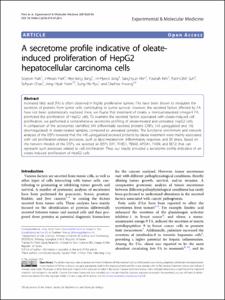A secretome profile indicative of oleate-induced proliferation of HepG2 hepatocellular carcinoma cells
- Title
- A secretome profile indicative of oleate-induced proliferation of HepG2 hepatocellular carcinoma cells
- Author(s)
- Park, Soyeon ; Park, Ji-Hwan ; Jung, Hee-Jung ; Jang, Jin-Hyeok ; Ahn, Sanghyun ; Kim, Younah ; Suh, Pann-Ghill ; Chae, Sehyun ; Yoon, Jong Hyuk ; Ryu, Sung Ho ; Hwang, Daehee
- Issued Date
- 2018-08
- Citation
- Experimental and Molecular Medicine, v.50, no.8, pp.1 - 14
- Type
- Article
- Keywords
- ENDOPLASMIC-RETICULUM-STRESS ; MIGRATION INHIBITORY FACTOR ; UNSATURATED FATTY-ACIDS ; BREAST-CANCER CELLS ; CANDIDATE SEROLOGICAL BIOMARKERS ; THIOL OXIDOREDUCTASE ERP57 ; UNFOLDED PROTEIN RESPONSE ; PANCREATIC-CANCER ; MASS-SPECTROMETRY ; INDUCED APOPTOSIS
- ISSN
- 1226-3613
- Abstract
- Increased fatty acid (FA) is often observed in highly proliferative tumors. FAs have been shown to modulate the secretion of proteins from tumor cells, contributing to tumor survival. However, the secreted factors affected by FA have not been systematically explored. Here, we found that treatment of oleate, a monounsaturated omega-9 FA, promoted the proliferation of HepG2 cells. To examine the secreted factors associated with oleate-induced cell proliferation, we performed a comprehensive secretome profiling of oleate-treated and untreated HepG2 cells. A comparison of the secretomes identified 349 differentially secreted proteins (DSPs; 145 upregulated and 192 downregulated) in oleate-treated samples, compared to untreated samples. The functional enrichment and network analyses of the DSPs revealed that the 145 upregulated secreted proteins by oleate treatment were mainly associated with cell proliferation-related processes, such as lipid metabolism, inflammatory response, and ER stress. Based on the network models of the DSPs, we selected six DSPs (MIF, THBS1, PDIA3, APOA1, FASN, and EEF2) that can represent such processes related to cell proliferation. Thus, our results provided a secretome profile indicative of an oleate-induced proliferation of HepG2 cells. © 2018, The Author(s).
- Publisher
- Nature Publishing Group
- Files in This Item:
-
 기타 데이터 / 1.02 MB / Adobe PDF
download
기타 데이터 / 1.02 MB / Adobe PDF
download



